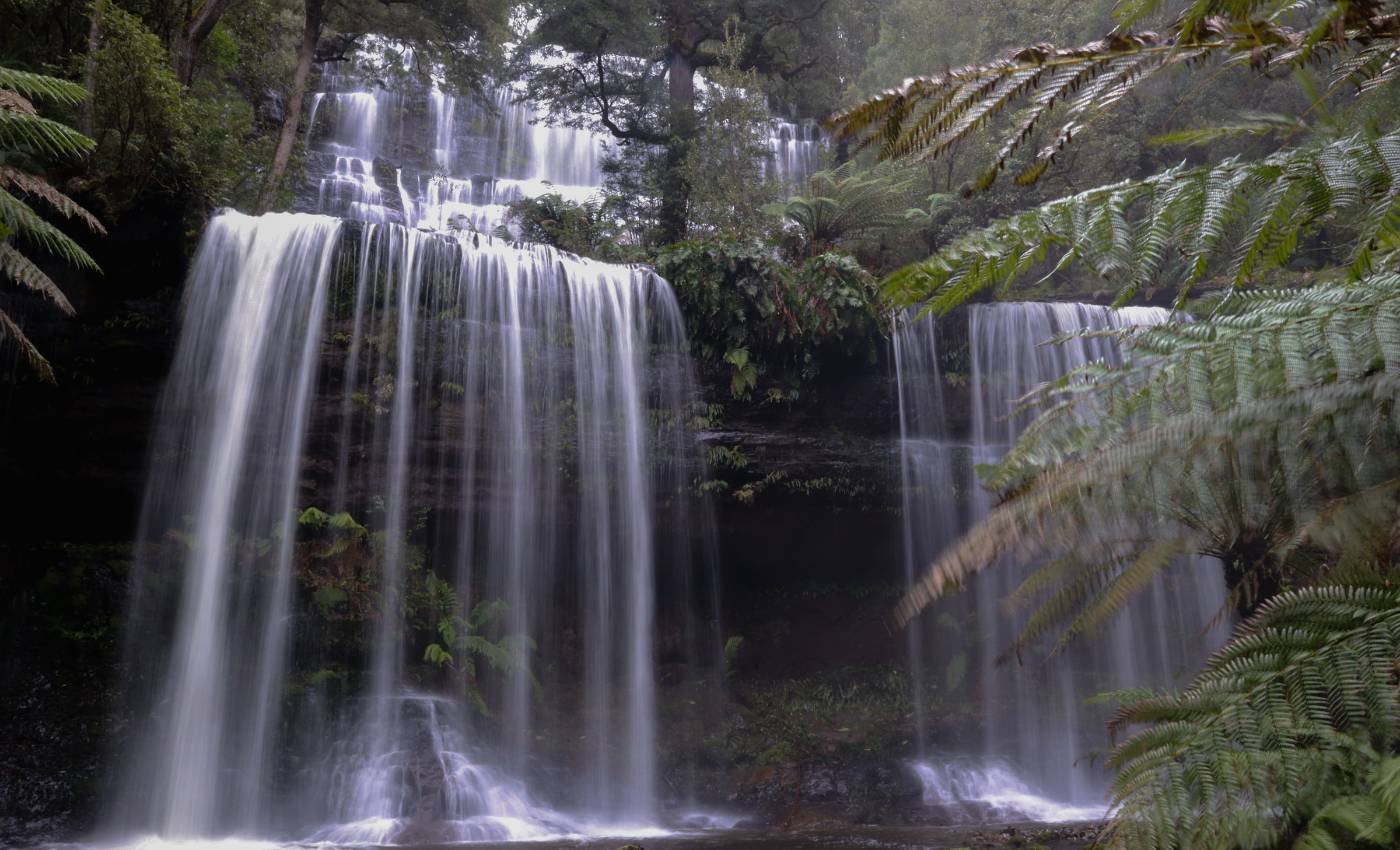
4 Days in Tasmania: A Complete Road Trip Guide for Explorers
Nature is the source of all true knowledge
Leonardo da Vinci
I’d always heard whispers about Tasmania — a land of dramatic peaks, curious wildlife, and coastlines so wild they could be lifted from a fantasy novel. After years of anticipation, my long-awaited trip finally became a reality, and I was ready to see if this little island lived up to its big reputation.
In just 4 days in Tasmania, a close friend and I journeyed from Hobart’s historic streets to the rugged heights of Cradle Mountain and the golden sands of Coles Bay, all under skies that couldn’t decide between snow, rain, or sunshine.
Despite its size, there’s no shortage of things to do in Tasmania — think mist-shrouded mountains, serene lakes, lush rainforests, and coastlines that steal your breath. So here it is: my 4 Day Tasmania Itinerary, designed to capture the very best of this wild and wonderful island.

This post contains affiliate links. If you make a purchase through these, I may earn a small commission at no extra cost to you, which helps me keep this blog running. Thanks for your support 🙂
Table of Contents
ToggleBest Time to Visit Tasmania
If you’re more used to warmer climates, the best time to go to Tasmania is between spring and early autumn (September to March) for milder conditions. For those visiting in winter (June to August), be ready for some serious cold, especially in the highlands where snow is common, like Cradle Mountain. While many attractions remain open, some trails and mountain roads may close due to weather conditions, so it’s important to check local forecasts and accessibility updates.
We visited in late October and experienced everything from a chilly snowfall at Cradle Mountain to clear, sunny skies at Coles Bay, and a little bit of rain between one destination to the other. Tasmania is known for its famously unpredictable weather—you can experience all four seasons in a single day—so packing layers is essential, even in summer!
How to Get Around Tasmania?
The most popular and cost-effective option to reach Tasmania is via flight to Hobart or Launceston from any major city in Australia. There are many airlines operating this route, such as Jetstar, Virgin and Qantas. Upon arrival, you will need transport to travel throughout the country. While long-distance buses are available, I highly recommend hiring your own vehicle. Why? Because it gives you the ultimate freedom to travel at your own pace! Imagine pulling over to snap that perfect photo of a stunning landscape or taking a spontaneous detour to explore a hidden gem along the way. Trust me, those unplanned stops often turn out to be the highlights of your trip!
If you are coming for a longer road trip, you may want to consider bringing your own vehicle from the mainland. In this case, your only option is to hop on the Spirit of Tasmania ferry, a scenic ride from Geelong (Victoria) to Devonport (Tasmania). You can also travel on the ferry as a passenger without a vehicle. The trip on board the ferry takes approximately 9-11 hours.
IMPORTANT TIP: As you drive through Tasmania’s breathtaking landscapes, you will notice the unfortunate sight of many dead animals along the roadside. Make sure you’re covered by good, reliable insurance.
National Park Pass
If you’re eager to explore Tasmania’s stunning natural attractions, you’ll likely find yourself visiting several national parks. To gain access, you’ll need to purchase a national park pass. A daily pass is available granting you entry for a full 24 hours. However, if you plan to visit multiple parks, consider investing in a holiday parks pass. This option offers exceptional value, providing access to all national parks and is valid for 2 months. It’s particularly cost-effective if you’re travelling with at least one other person, as the pass covers vehicles with up to 8 passengers. Passes can be bought online or in any national park’s visitor centre.
4 Day Tasmania Itinerary
This carefully crafted 4 day Tasmania itinerary showcases the island’s spectacular natural beauty and some of its must-see attractions. While 4 days in Tasmania may not cover every highlight, this itinerary offers a balanced mix of city vibes, outdoor adventures, and memorable wildlife encounters.
This adventure starts and finishes at Hobart Airport and focuses on the following destinations considering the available time:
- Hobart (arrival flight)
- Mt Wellington
- Russell Falls
- Cradle Mountain
- Coles Bay
- Hobart (departure flight)
Day 1
After an early start for our flight to Tasmania, we touched down in Hobart, ready for adventure. I recommend hiring a vehicle directly from the airport to skip the hassle and cost of a shuttle to the CBD.
Before setting off, consider making a quick stop for brekkie. Wander along Hobart’s Elizabeth Street and its surrounding lanes in the CBD, where cosy cafés serve some of the city’s finest coffee.
Given the available time to cover a long distance, I suggest tackling the longest drive on Day 1 to set a more relaxed pace for the rest of the trip.
Hobart Botanic Gardens
For those arriving in Hobart, the Royal Tasmanian Botanical Gardens is an excellent first stop to immerse yourself in Tasmania’s unique flora and landscapes. Spanning 14 hectares, this cool climate garden boasts a stunning collection of native and exotic plants, beautifully arranged landscapes, and serene walking paths. Conveniently located just 2 km north of Hobart CBD, the Gardens are open daily all year round, inviting you to wander and take in the natural beauty.


Mount Wellington
Next, I recommend heading to Mount Wellington (or kunanyi), Hobart’s towering peak, which offers breathtaking panoramic views of Hobart, the River Derwent, and Tasmania’s wild landscape beyond and a variety of hiking trails. Rising 1,271 metres above the city, this iconic mountain is just a 25-30 minute drive from the CBD. And if you’re exploring without a car, the kunanyi/Mt Wellington Explorer Bus makes reaching the summit easy.
As we wound our way up, I quickly learned that Mount Wellington has a personality of its own—the temperature dropped sharply, and our partially sunny day in Hobart turned into a swirling mix of snow, rain, and mist at the summit! This is classic Tasmania: weather that shifts on a dime. Though the clouds obscured the view I’d hoped for, the unexpected snowfall was a beautiful surprise, especially for spring.
With free access year-round (barring any emergency closures), Mount Wellington is a must-see. Beyond its stunning views, the mountain offers fantastic trails for every type of hiker, including the popular Zig Zag track, Organ Pipes and Pinnacle track.

Russell Falls
After some exploring in Hobart, we set off northwest to Russell Falls, our first destination outside the city and probably the most iconic waterfall in Tasmania. Just a little over an hour’s drive from Hobart, Russell Falls is located within Mount Field National Park, Tasmania’s oldest national park, dating back to 1916. It’s also part of the Tasmanian Wilderness World Heritage Area—a testament to its natural beauty and importance.
Arriving at the falls felt like stepping into a lush, green oasis. Russell Falls is incredibly picturesque, featuring tiered cascades that create a stunning “veil” effect as water tumbles into a fern-lined pool. The walk to the base of the falls is a breeze, —an easy, 25-minute return trail from the visitor centre that’s both sealed and accessible. Here, we purchased our national park pass, which offers access to all of Tasmania’s parks for two months, providing great value, although one-day passes are also available.
This trail, one of Tasmania’s 60 Great Short Walks, leads you through towering mountain ash trees and thick temperate rainforest, setting the stage perfectly for the waterfall reveal.



Sleep: Cradle Mountain
To wrap up Day 1, we decided to stay overnight at Cradle Mountain, eager to make the most of our limited time. This was our longest drive, taking just under four hours from Russell Falls. Along the way, we encountered intense rain and snowfall but arrived just as the last light of the day faded.
We stayed at Discovery Parks, conveniently located across from the Cradle Mountain visitor centre. Our cabin was comfortable, with good showers, several shared kitchens, and great amenities. Given that accommodation at Cradle Mountain is both limited and relatively pricey, this option offered exceptional value for money.
Day 2
Cradle Mountain
Located in Tasmania’s Cradle Mountain–Lake St Clair National Park, Cradle Mountain is one of the island’s most breathtaking icons. With rugged alpine peaks, pristine lakes, diverse wildlife, and world-class hikes, it’s no wonder it’s considered one of Australia’s top adventure destinations.
The park offers dramatic landscapes and trails for everyone — from families and beginners to seasoned hikers. To visit, you’ll need a national park pass plus a $15 AUD return bus ticket from the visitor centre, which shuttles between Snake Hill, Ronny Creek, and Dove Lake.
For a perfect introduction, try the Dove Lake Circuit. This 6 km Grade 3 trail takes 2–3 hours and loops around Dove Lake with stunning views of Cradle Mountain’s jagged summit. Expect some rocky terrain, snow, and steep sections, but nothing too difficult. The walk ends at the iconic boatshed — a picture-perfect Tassie moment.


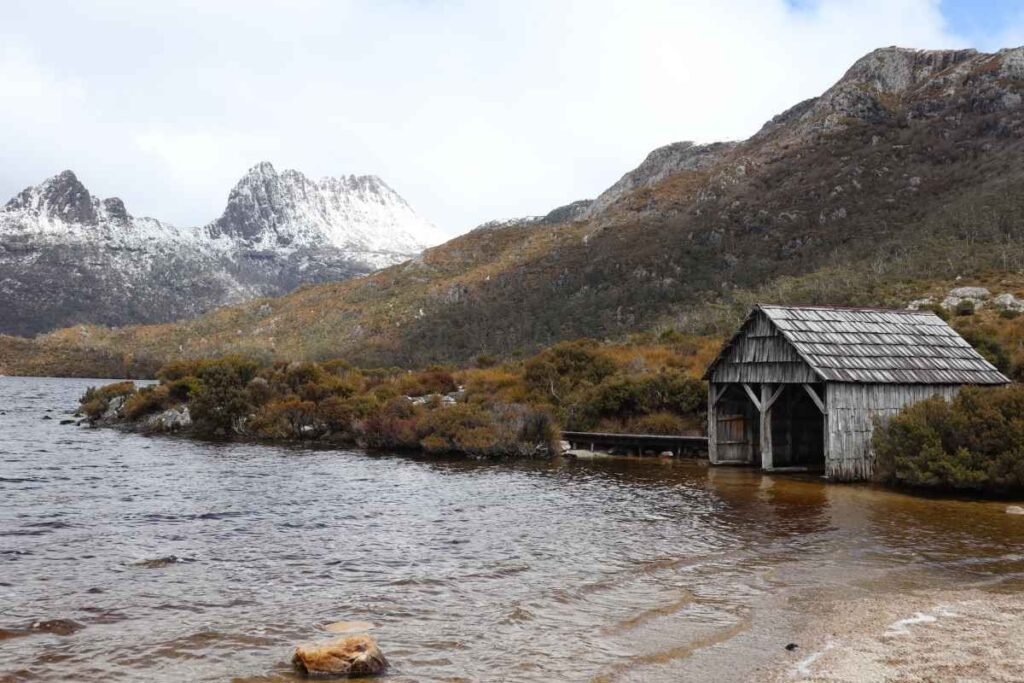
Other famous and iconic hiking options include the Enchanted Walk (Grade 2, 1.1 km – 20 min circuit), Cradle Summit (Grade 5, 12.8 km, 8-hour circuit), and the Overland Track (Grade 4, 65 km one-way hike).
Beyond the trails, Cradle Mountain is a haven for Tasmanian wildlife. If you’re keen to spot wombats, head over to Ronny Creek. Take a stroll along the boardwalks, and you’re likely to see a few munching away (they won’t even mind your presence—it’s as if they know they’re the stars here!). The wildlife is remarkably laid-back, and you might even encounter wallabies or echidnas just going about their day.


Sleep: Launceston
I would’ve loved to stay longer in Cradle Mountain, but with our limited time, we had to make our way to our next destination, Coles Bay. We decided to stop halfway in Launceston to refuel, stock up on groceries, and get some sleep after a tiring day. The drive from Cradle Mountain to Launceston took us about 1 hour and 50 minutes (140 km), and we arrived just before dusk, giving us some time to explore the city on foot.
For a comfortable stay steeped in history, the Quality Hotel Colonial Launceston, a Victorian-era heritage site that once housed a school, offers modern amenities, a charming on-site bar and restaurant, and a great location just a short stroll from Launceston’s CBD and riverside. It’s the perfect base to relax and explore the city’s vibrant dining and cultural scene!
Day 3
Coles Bay - Freycinet National Park
The drive from Launceston to Coles Bay took us just over two hours, and it was like flipping through a photo album of Tasmania’s best landscapes. You’ll cruise past charming farmlands dotted with sheep, endless green pastures, and vineyards that make the rolling hills look like they’re straight out of a painting.


Coles Bay is a charming coastal town nestled at the edge of Freycinet National Park, a gem on Tasmania’s east coast. This park is famed for its rugged coastlines, secluded beaches, and dramatic pink granite peaks. It’s a place where wild landscapes meet crystal-clear waters, and every view feels like something from a postcard.
With only 4 days in Tasmania, we were determined to make the most of it by tackling the Wineglass Bay and Hazards Beach Circuit—the park’s most popular hike. This Grade 4 trail spans 11 km and usually takes 3-4 hours to complete. Being a loop, you can start in either direction: toward Hazards Beach or the Wineglass Bay Lookout. We chose to head to Hazards Beach first, leaving the breathtaking lookout as the icing on the cake.
Starting from the car park, the trail quickly opened up with a mix of bushland and coastal views, with just enough uphill stretches to keep things exciting. Hazards Beach rewarded us with soft, white sand and water that shifted from deep blue to vibrant turquoise, looking almost surreal in the sunlight. We took a quick snack break here, soaking in the peaceful beauty before moving on.
From Hazards Beach, there’s a unique section where you walk directly on the sand to reach Wineglass Bay Beach. On a sunny day, the water looked impossibly clear and the colours almost too vibrant to believe—who knew Tasmania had beaches this gorgeous?
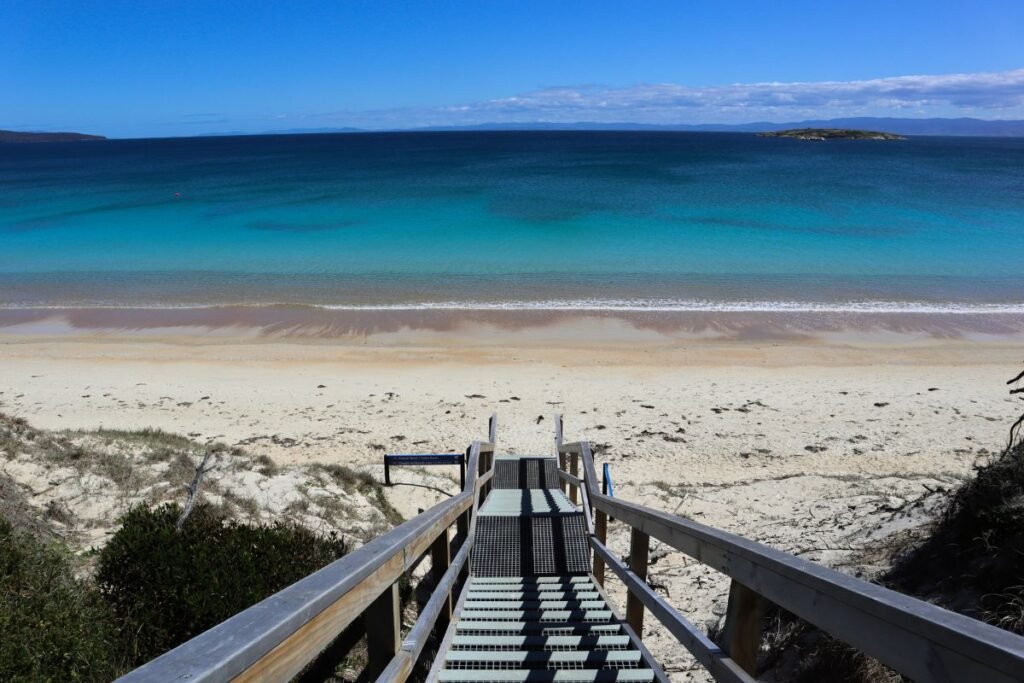


Wineglass Bay was just as stunning, although the weather decided to remind us we were in Tassie as the wind suddenly picked up and brought a chill. We took a few photos of the beach’s striking red-orange rocks, a result of lichen that adds an otherworldly splash of colour to the shore.
With the chill in the air, we pushed on toward the lookout, tackling what felt like a million steps along the way. Halfway up, we were starting to doubt our decision to save the lookout for last! But the moment we reached the platform, all those steps faded away. This view is without a doubt one of the most iconic in Tasmania. The contrast of the white sand, brilliant blue water, and rugged cliffs takes your breath away—absolutely worth every step.
From the viewing platform to the carpark it was a 20 minute walk, we decided to get going to our next destination before dusk.


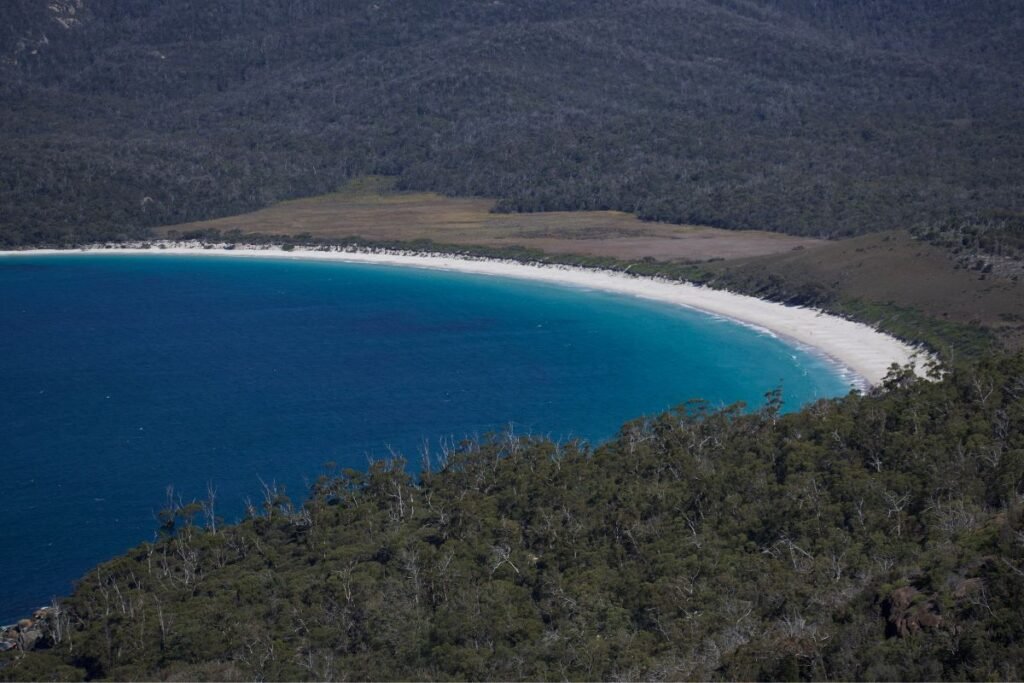
Sleep: Swansea
Swansea is a quiet seaside town, which has only one main road, a few interesting old buildings and a few accommodation and eating options. It’s a 60 km drive from Freycinet National Park, and took us around 50 minutes to get there. It’s also situated on the east coast of Tasmania, offering lovely views over Great Oyster Bay. After a full day in Coles Bay, Swansea made for an ideal stop to unwind—it’s quiet, scenic, and has just the right touch of coastal charm. It was the right stop before heading back the following day to our first and also final destination, Hobart, where our flight back home awaited us.
We stayed at The Waterloo Hotel and it was a really good choice, the room was big, with great sea views, and a private bathroom with good showers. The staff was super friendly. It was overall a really good value for money.
Day 4
Hobart
Our final day in Tasmania started with a touch of sadness—it was hard to believe the trip was coming to an end. Determined to make the most of it, though, we set off early, knowing we had until the evening to explore. The drive from Swansea will take you about an hour and 45 minutes, with a few stops along the way to capture some last shots of the coast and soak up the scenery.
Once in Hobart, you may want to head straight into the CBD to wander through its charming mix of historic buildings and bustling eateries. Sampling fresh Tasmanian fish at Mures Lower Deck was a non-negotiable for me as a seafood lover, and it absolutely delivered. Fueled by delicious food and coffee, you can spend the afternoon snapping street photos and taking in the lively yet relaxed atmosphere.
To wrap up your adventure, drive to Rosny Hill Lookout for a final panoramic view of Hobart. From up there, we had sweeping views of the Derwent River, Tasman Bridge, and the city sprawled below, with Rosny Bay and the Royal Tasmanian Botanical Gardens adding to the scene. It was a perfect way to say goodbye, capturing one last unforgettable memory before heading to the airport.



Final Thoughts
After spending 4 days in Tasmania, I can confidently say this island lives up to every bit of its reputation — and then some. Tasmania delivered a perfect mix of adventure, beauty, and surprises (including that classic four-seasons-in-a-day weather!). While there are countless things to do in Tasmania, this trip showed me that even a short visit can be packed with unforgettable moments.
If you’re planning your own adventure, this 4 Day Tasmania itinerary is proof that you don’t need weeks to experience the island’s magic — just good shoes, a sense of wonder, and maybe an extra layer (or three). Tassie, I’ll definitely be back.


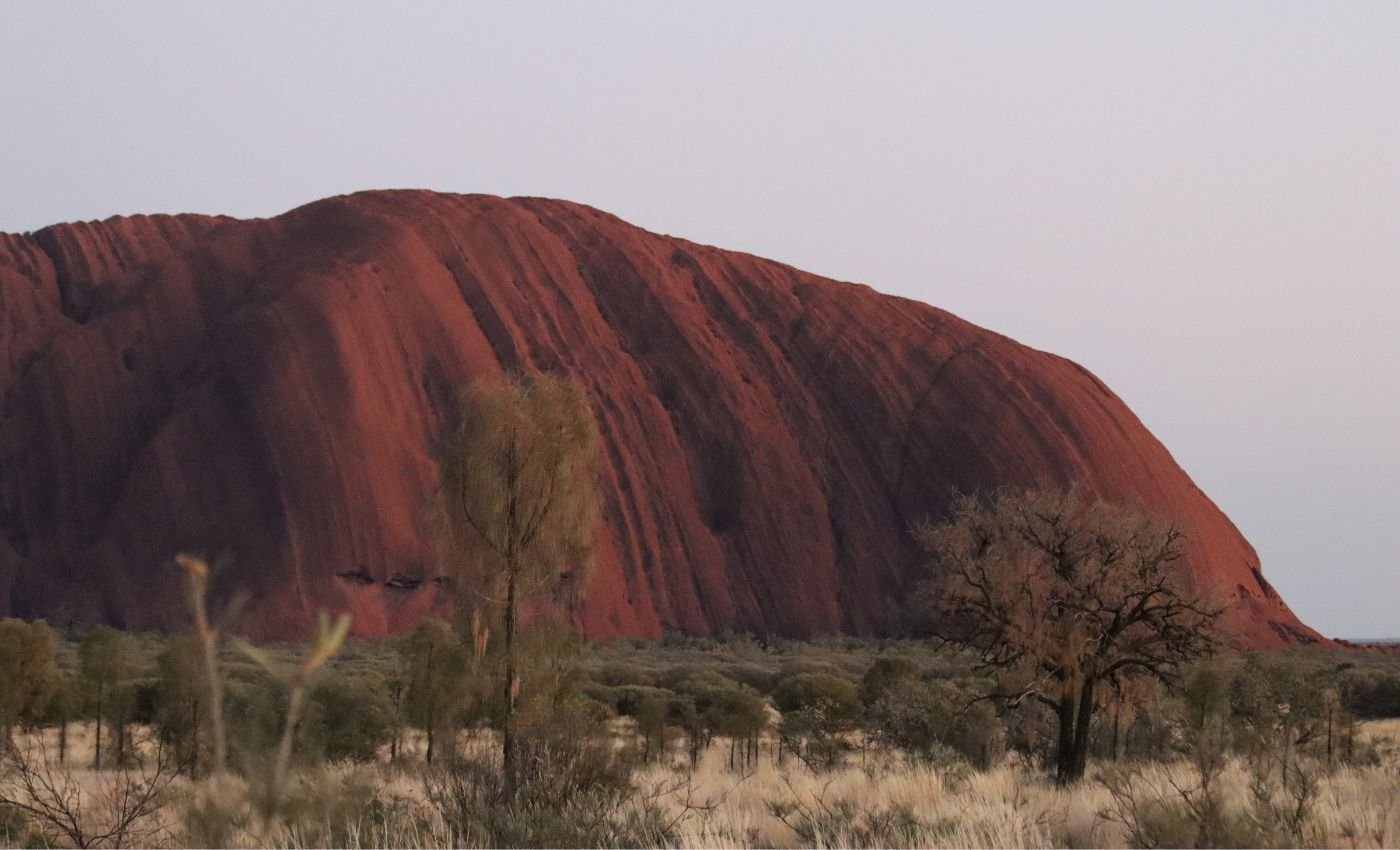
Leave a Reply